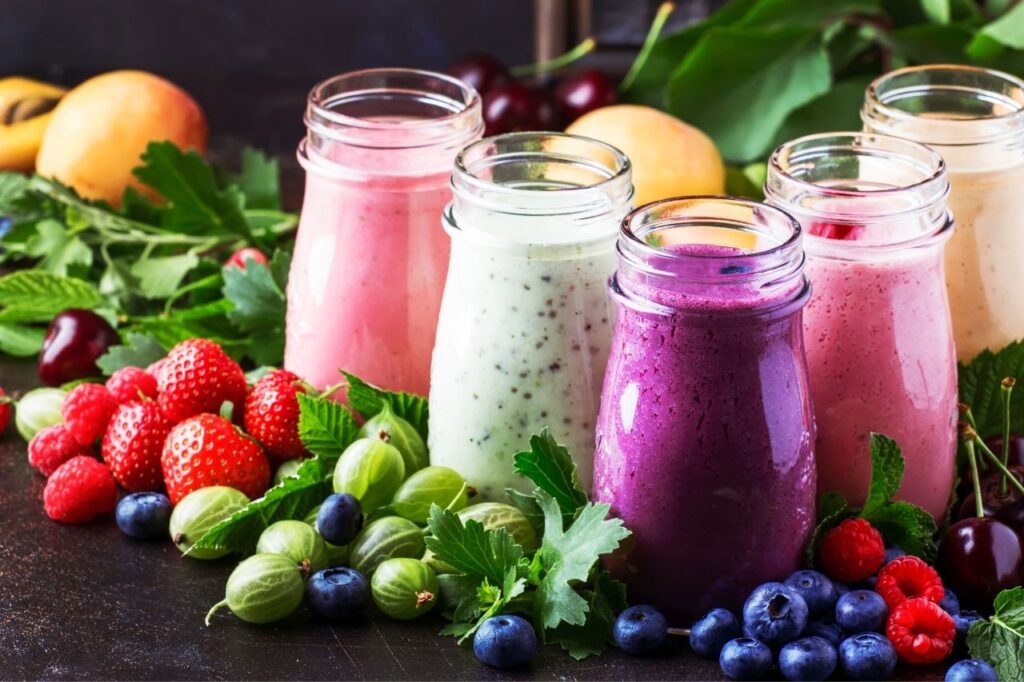Smoothies: Everything you need to know for getting started
Smoothies are a popular wellness trend and frequently marketed as health foods. These versatile beverages are portable, family-friendly and easily modifiable to your taste or dietary preferences.
They can purchased pre-produced from specialty cafés and most major grocery stores. While some types contain lots of vegetables or fruit, others pack sugar or other unhealthy ingredients, so you may wonder whether they are a healthy choice for you! But by preparing and mixing the smoothie yourself, you always have full control over it’s ingredients and therefore it’s taste and nutrient richness.
This article points on everything you need to know about smoothies and their potential benefits (including weight loss) but also what might make them less than optimal if not paired with the right macronutrients.

Topics in this Guide
• What are Smoothies?
‣ Different Types
‣ Commonly used Ingredients
• Are you exited to give it a go?
• Smooth(ie) Benefits
‣ Increased Vitamin Intake
‣ Important Fiber
‣ A tasty weight loss aid
• What’s important?
‣ Beware of too much sugar
• Tools & Accessories
‣ Blender
• What’s next?
‣ Tailor your smoothie
‣ Experimenting
• Fast-tracking your diet
What Are Smoothies?
Most commonly the result of mixing and blending yogurt, fruit, nut or seeds and/or dairy or nondairy milk together will be called smoothie; which will also be thicker than a fruit juice. They can be made with any combination of the aforementioned ingredients as well as vegetables. Smoothies have become popular in recent years because they pack so many nutrients from fruits and veggies into one drink which is outstandingly refreshing!
Smoothies are made from two essential parts: a mix of different fruits and/or vegetables and a liquid (sometimes called the base). A third part might be (crushed) ice to get a cool refreshing beverage. From there, you can add the ingredients you like; also including whey, sweeteners like honey and many more.
Your result will vary in flavor, depending on the ingredients. Some smoothies include frozen produce or other green vegetables to move in direction of a “Green Smoothie”. But also increasing the ratio of ice cubes, while reducing the liquid base, to give it that cool and icy consistency of a milkshake is a way to go.
Different Types
Smoothies are so customizable that they’re fairly easy to pack with nutrients. They can be classified into 3 main categories which are:
- Green smoothies: Green smoothies are made of leafy green vegetables and fruit blended with water, juice, or milk. They tend to be heavier in veggies than regular smoothies, but they often include a some fruit for better taste and sweetness.
- Fruit smoothies: This type of smoothie often features one or more types of fruit blended with juice, water, milk or ice cream.
- Protein smoothies: They are made of one to two fruits or vegetables (e.g. soy) and a liquid, as well as the protein source. These could be yogurt, cottage cheese, silken tofu or protein powder for instance.
Commonly Used Ingredients
- Liquid: water, fruit juice, vegetable juice, milk, nondairy milk, coconut water, iced tea, cold brew coffee
- Fruits: banana, apple, berries, peach, mango, pineapple
- Vegetables: spinach, arugula, kale, avocado, cucumber, beetroot, cauliflower, carrots
- Nuts and seeds: almond, peanut, walnut, sunflower seed, chia seeds
- Herbs and spices: ginger, turmeric, cinnamon, cocoa powder, cacao nibs, parsley, basil
- Supplements: spirulina, bee pollen, matcha powder, protein powder, and powdered vitamin or mineral supplements
- Sweetener: sugar, honey, dates, syrup, fruit juice concentrates, ice cream, sorbet, stevia
- Other: cream cheese, vanilla extract, oats, cooked white beans, tofu, yogurt, whey
